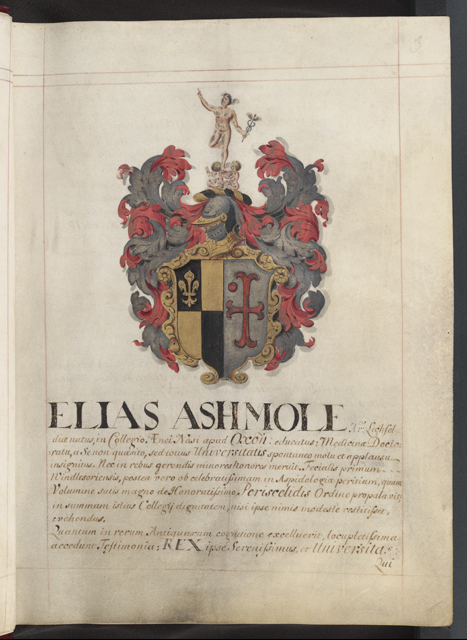Book of Benefactors
Browse Collection
12 of 73
Right-click on image to "Save Picture As ..."; Left-click to hide this image

Elias Ashmole Esq. was born in Lichfield ...
Latin Text:
ELIAS ASHMOLE A: Lichfeldi
Translation:
Elias Ashmole Esq. was born in Lichfield and educated at Brasenose College, Oxford. He did not himself supplicate for a Doctorate in medicine, but was singled out for this honour by the spontaneous acclamation of the whole University. Nor in his active life did he deserve any less honour. He was first Windsor Herald and, on account of his celebrated expertise in the field of heraldry, which he displayed to the full in a large book he wrote on the most noble Order of the Garter, would subsequently have been raised to the highest honour in the College, had he not modestly declined the offer.
-
His knowledge and excellence in the field of antiquities is abundantly confirmed by reliable sources, including His Majesty the King and the University which entrusted to him the task of arranging the antiquities [
And he gave objects, both Roman and of people from almost every part of the world - arms, clothing, jewels, statues of gods, sacrificial vessels, burial urns and lachrymatories, and furthermore, to the rarer and more notable treasures of the museum, he added coins, statues, pictures and paintings. The most noble Ashmole graced this museum as much with his own name as with artefacts from all over the world. And since this volume would scarcely be large enough to record all these objects individually, another catalogue will be ordered, at a suitable time, in which they will be listed separately by type.
In his second series of gifts, the most illustrious Elias Ashmole gave 556 silver coins - Roman, English and Scottish ones among them. The same distinguished Ashmole also brought portraits of King Charles and King James of England, in elegantly carved and gilded frames.
This most excellent of men, Elias Ashmole Esq., bestowed upon his Museum an original gold medal remarkable for both its size and its form, which King Karl Gustav of Sweden had gratefully sent to his chief astrologer, William Lilly, for certain favourable prognostications he had received and which, in the event, proved to be true. In the year 1692 this great man ceased to promote literary activities and to add to the Museum's collection of the treasures of nature and art. To the end of his life he was eager to establish learning of all kinds and, to that end, he bequeathed 1,700 books, at least 600 of which are in manuscript, to the library, which for this reason we have provided with an inscription of his name. In addition, he wanted his Praemia Honoraria, the golden chains and medals, which he had received from those best of princes, the King of Denmark and the Duke of Brandenburg, and others, in recognition of his indefatigable work and achievements, to be preserved in this Museum after his death, so that, by stirring their ambition, he might, by his own example, encourage young men to pursue their studies with greater enthusiasm.
Related Objects:HCR7579-7583, WA1898.37-40
Location:Praemia Honoraria, other medals and coins - Heberden Coin Room. Portraits of King Charles I, King Charles II and King James II - Department of Western Art. Books and manuscripts transferred to the Bodleian Library in 1860. Some objects are on display in Gallery 8 (Ark to Ashmolean).
Year:MDCLXXXIII (1683); Page Number: 3 (recto), 3 (verso), 4(recto)

|
Click on image for 'zoomable' version |

.jpg)
